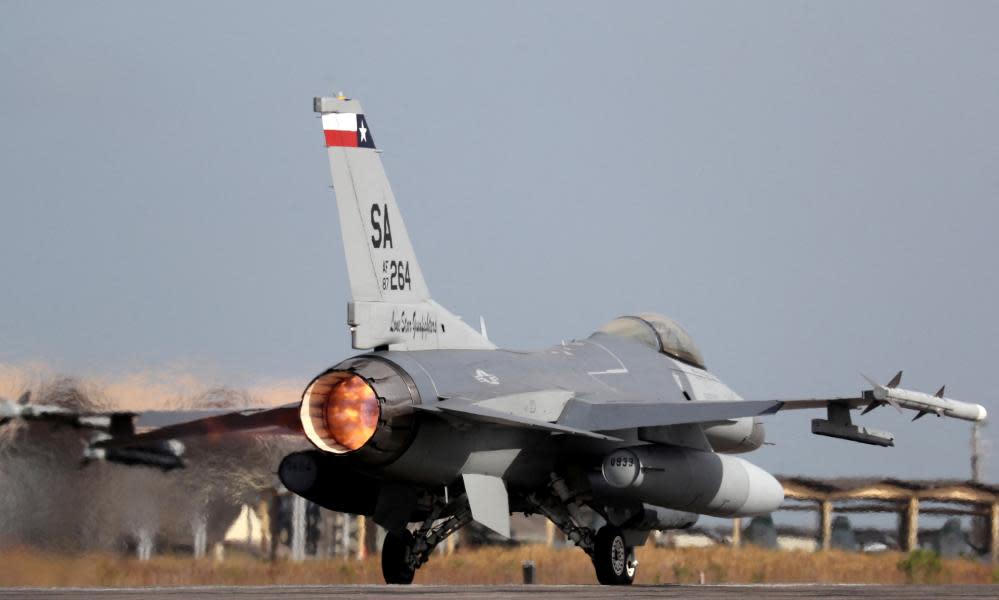US and UK rule out sending F-16 fighter jets to Ukraine

Western allies appear to have retreated from supplying F-16 and other western fighter jets to Ukraine over the past 24 hours, with the UK joining the US in quashing Kyiv’s hopes it could obtain the jets soon after the west agreed to send it tanks.
US president, Joe Biden, when asked at the White House late on Monday if his country would provide F-16s, answered simply “no”, although he emphasised on Tuesday morning he would remain in discussions with Ukraine about its weapons requests.
Later on Tuesday, the UK also said supplying western jets was not practical. “These are sophisticated pieces of equipment,” a Downing St spokesperson said. “We do not think it is practical to send those jets into Ukraine.”
Ukraine responded by saying it would continue lobbying, arguing that the west had repeatedly said no to supplying weapons such as tanks before relenting over time. Oleksii Reznikov, the defence minister, said on a visit to Paris: “All types of assistance at the beginning went through the ‘no’ stage. This means ‘no’ as of today.”
His French counterpart, Sébastien Lecornu, reiterated there was “no taboo” on the supply of jets, echoing similar remarks made by Emmanuel Macron on Monday evening. France also said it would donate 12 Caesar howitzers to Ukraine after the summit between the two ministers.
The French president had said that “nothing is excluded in principle” when asked about western fighter jets for Ukraine – but he then laid out a series of criteria before making a decision.
Any delivery would have to “not be escalatory”, Macron said, and the jets could “not be likely to hit Russian soil but purely to aid the resistance effort”. Arms supply must also not weaken the capacity of the French armed forces, he added.
Ukraine had begun a high-profile lobbying campaign for the fighters, manufactured by the US defence company Lockheed Martin, almost immediately after Germany and the US said they would supply their own tanks to Ukraine for the first time earlier this month.
Air force spokesman Yuri Ignat said on Tuesday that Ukraine was seeking 200 fighter jets, to create “five brigades of tactical aviation” ideally with one type of multi-purpose aircraft of western design in order to help it achieve a military breakthrough.
Ukraine’s small air force has been reduced over the 11-month war, and while it has some jets still operational, it has at best a very limited capacity to take on Russia’s air force and help its ground forces attack entrenched Russian positions.
Biden’s decision represents a serious knockback, at least for now, and it likely to be partly based on concerns that the Kremlin could argue that F-16s could be used to hit targets inside Russia, and so could be readily interpreted by Moscow as a significant escalation in the war.
There was more positive news for Kyiv on tanks, with Ukraine’s foreign secretary, Dmytro Kuleba, announcing that Kyiv had received commitments to send 120 to 140 western tanks in a “first wave” of deliveries, including German-made Leopard 2s, Abrams from the US and Challenger 2 tanks from the UK.
On Monday, the Kremlin spokesperson Dmitriy Peskov argued that while western countries supplying arms led to Nato countries “more and more becoming directly involved in the conflict” it would not change the course of the war.
Washington previously intervened to stop Poland transferring its fleet of MiG-29s, familiar to Ukrainian pilots, in the early stages of the war – but Kyiv had hoped the climate would change given that the White House has authorised the supply of US-made Abrams tanks after several months of holding out.
There are about 3,000 F-16s operational worldwide and the jet is in service in 25 countries. A Ukrainian air force spokesperson has said it would take its pilots about six months to train on such fighter jets, although there is also a requirement to train ground staff to fix and maintain them.
A western official also said in a briefing on Tuesday that military casualties on both sides in the war, now approaching the one year mark, totalled around 200,000 – with a similar number killed and wounded on either side.
A higher proportion of Russians had been killed however, the official added, because they had been on the offensive, meaning that “they’ve suffered more fatalities than the Ukrainians on balance”.

 Yahoo Movies
Yahoo Movies 
